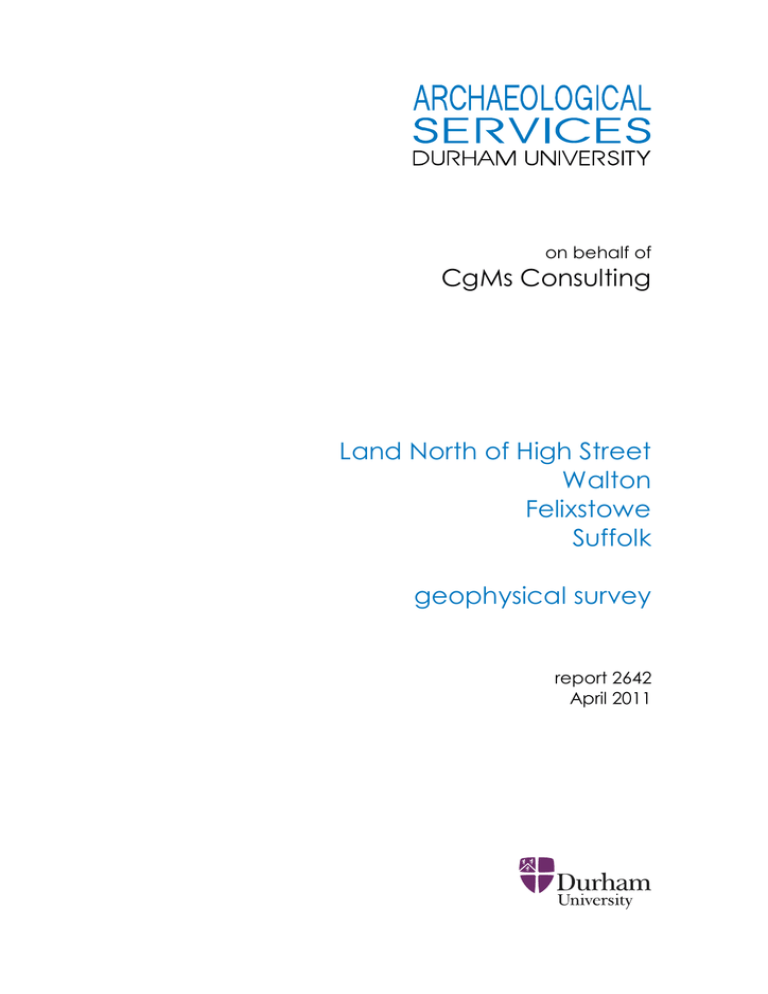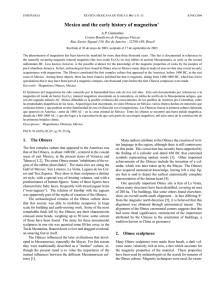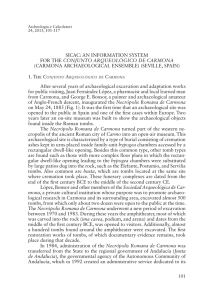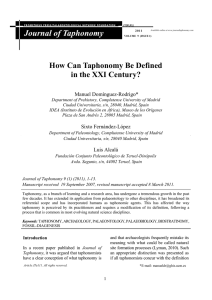CgMs Consulting Land North of High Street Walton Felixstowe
Anuncio

on behalf of CgMs Consulting Land North of High Street Walton Felixstowe Suffolk geophysical survey report 2642 April 2011 Contents 1. 2. 3. 4. 5. 6. 7. Summary Project background Historical and archaeological background Landuse, topography and geology Geophysical survey Conclusions Sources 1 2 2 3 3 6 7 Figures Figure 1: Figure 2: Figure 3: Figure 4: Figure 5: Figure 6: Figure 7: Survey location Geophysical survey, overview at 1:2000 Geophysical survey, unfiltered data Geophysical survey, filtered data Geophysical interpretation Archaeological interpretation Trace plot of geomagnetic data © Archaeological Services Durham University 2011 South Road Durham DH1 3LE tel 0191 334 1121 fax 0191 334 1126 archaeological.services@durham.ac.uk www.dur.ac.uk/archaeological.services Land North of High Street· Walton· Felixstowe· Suffolk· geophysical survey· report 2642· April 2011 1. Summary The project 1.1 This report presents the results of a geophysical survey conducted in advance of proposed development of land north of High Street, Walton, Felixstowe, Suffolk. The works comprised the geomagnetic survey of 12 hectares of arable land. 1.2 The works were commissioned by CgMs Consulting and conducted by Archaeological Services Durham University. 1.3 A number of curvilinear anomalies were identified across the site which could possibly reflect the remains of ring-ditches. One of the larger of these anomalies, on the northern edge of the site, corresponds to a cropmark on aerial photographs, which has been interpreted as a Bronze Age round barrow. 1.4 Probable ditches were detected across the site which could reflect medieval or earlier, possibly prehistoric, boundaries. 1.5 Ground disturbance, probably associated with gravel extraction, was detected in the south-east corner of the survey area. 1.6 Two known former field boundaries, a backfilled pond and modern services were also detected. Results Archaeological Services Durham University 1 Land North of High Street· Walton· Felixstowe· Suffolk· geophysical survey· report 2642· April 2011 2. Project background 2.1 The survey area was located on land north of High Street, Walton, Felixstowe, Suffolk (NGR centre: TM 290 360). One survey totalling approximately 12ha was conducted in one land parcel. The site is bounded by High Street to the south, the A154 Candlet Road to the north, the A14 Port of Felixstowe Road to the west and residential housing to the east. The south-west corner of the site was occupied by disused paddocks and a rifle range. 2.2 The development proposal is for a mixed-use development comprising residential, commercial and recreational facilities. Location (Figure 1) Development proposal Objective 2.3 The principal aim of the survey was to assess the nature and extent of any subsurface features of potential archaeological significance within the proposed development area, so that an informed decision may be made regarding the nature and scope of any further scheme of archaeological works that may be required in relation to the development. Methods statement 2.4 The surveys have been undertaken in accordance with a Written Scheme of Investigation provided by Archaeological Services Durham University and approved by the Suffolk County Archaeologist. Dates 2.5 Fieldwork was undertaken between 21st and 25th March 2011. This report was prepared during April 2011. Personnel 2.6 Fieldwork was conducted by Tom Fitton and Natalie Swann (Supervisor). Geophysical data processing and report preparation were conducted by Natalie Swann and Duncan Hale, the Project Manager, with illustrations by David Graham. Archive/OASIS 2.7 3. The site code is SFW11, for Suffolk, Felixstowe, Walton 2011. Archaeological Services Durham University is registered with the Online AccesS to the Index of archaeological investigationS project (OASIS). The OASIS ID number for this project is archaeol3-98702. Historical and archaeological background Previous archaeological works 3.1 An archaeological desk-based assessment has been undertaken for this site (Chadwick & Smith 2010). The results of that assessment are summarised below. No other previous archaeological work has been undertaken within the proposed development area. Archaeological Services Durham University 2 Land North of High Street· Walton· Felixstowe· Suffolk· geophysical survey· report 2642· April 2011 The prehistoric period (up to AD 70) 3.2 The Suffolk Historic Environment Record (HER) notes three Bronze Age ring-ditches, interpreted from aerial photography, within the proposed development area (PDA). These ring-ditches are likely to be part of a wider prehistoric landscape as six further Bronze Age ring-ditches and prehistoric field systems and recorded within 1km of the PDA. The Roman period (AD 70 to 5th century) 3.3 There is no direct evidence of Roman occupation within the PDA but evidence for Roman occupation has been recorded 900m south-west of the site. 3.4 The PDA lies outside the medieval centre of Walton and was likely to have been farm land during the medieval period. The medieval period (5th century to 1540) The post-medieval and modern period (1541 to present) 3.5 Historic and modern maps show that the south-west corner of the site and the south edge of the site along High Street have been developed since the post-medieval period; the rest of the site has remained as open farm land. Quarrying was also noted on the west edge of the PDA. 4. Landuse, topography and geology 4.1 At the time of survey the proposed development area comprised a single field of arable land ploughed into ridges for potatoes. The ridges were aligned northwest/south-east, except around the field edges where they ran parallel to the field edges. It was not possible to collect data in the south-west corner of site due to overgrown vegetation within the paddocks. 4.2 The area was predominantly level with a mean elevation of approximately 22m OD. The site lies approximately 3km from the Felixstowe coast. 4.3 The underlying solid geology of the area comprises Neogene Red Crag Formation (sand), which is overlain by Quaternary drift geology of Kesgrave Catchment Subgroup sand and gravel. 5. Geophysical survey Standards 5.1 The surveys and reporting were conducted in accordance with English Heritage guidelines, Geophysical survey in archaeological field evaluation (David, Linford & Linford 2008); the Institute for Archaeologists (IfA) Draft Standard and Guidance for archaeological geophysical survey (2010); the IfA Technical Paper No.6, The use of geophysical techniques in archaeological evaluations (Gaffney, Gater & Ovenden 2002); and the Archaeology Data Service Guide to Good Practice: Geophysical Data in Archaeology (draft 2nd edition, Schmidt & Ernenwein 2010). Technique selection 5.2 Geophysical survey enables the relatively rapid and non-invasive identification of sub-surface features of potential archaeological significance and can involve a suite Archaeological Services Durham University 3 Land North of High Street· Walton· Felixstowe· Suffolk· geophysical survey· report 2642· April 2011 of complementary techniques such as magnetometry, earth electrical resistance, ground-penetrating radar, electromagnetic survey and topsoil magnetic susceptibility survey. Some techniques are more suitable than others in particular situations, depending on site-specific factors including the nature of likely targets; depth of likely targets; ground conditions; proximity of buildings, fences or services and the local geology and drift. 5.3 In this instance, based on aerial photographic cropmark evidence it was considered likely that cut features such as ditches and pits might be present on the site, and that other types of feature such as trackways, wall foundations and fired structures (for example kilns and hearths) might also be present. 5.4 Given the anticipated shallowness of targets and the non-igneous geological environment of the study area a geomagnetic technique, fluxgate gradiometry, was considered appropriate for detecting the types of feature mentioned above. This technique involves the use of hand-held magnetometers to detect and record anomalies in the vertical component of the Earth’s magnetic field caused by variations in soil magnetic susceptibility or permanent magnetisation; such anomalies can reflect archaeological features. Field methods 5.5 A 30m grid was established across the survey area and tied-in to known, mapped Ordnance Survey points using a total station survey instrument. 5.6 Measurements of vertical geomagnetic field gradient were determined using Bartington Grad601-2 dual fluxgate gradiometers. A zig-zag traverse scheme was employed and data were logged in 30m grid units. The instrument sensitivity was nominally 0.03nT, the sample interval was 0.25m and the traverse interval was 1m, thus providing 3,600 sample measurements per 30m grid unit. 5.7 Data were downloaded on site into a laptop computer for initial processing and storage and subsequently transferred to a desktop computer for processing, interpretation and archiving. Data processing 5.8 Geoplot v.3 software was used to process the geophysical data and to produce both a continuous tone greyscale image and a trace plot of the raw (minimally processed) data. A plot of filtered data is also provided. The greyscale images and interpretations are presented in Figures 2-6; the trace plot is provided in Figure 7. In the greyscale images, positive magnetic anomalies are displayed as dark grey and negative magnetic anomalies as light grey. A palette bar relates the greyscale intensities to anomaly values in nanoTesla. 5.9 The following basic processing functions have been applied to the geomagnetic data: clip clips data to specified maximum or minimum values; to eliminate large noise spikes; also generally makes statistical calculations more realistic Archaeological Services Durham University 4 Land North of High Street· Walton· Felixstowe· Suffolk· geophysical survey· report 2642· April 2011 zero mean traverse destagger interpolate 5.10 sets the background mean of each traverse within a grid to zero; for removing striping effects in the traverse direction and removing grid edge discontinuities corrects for displacement of geomagnetic anomalies caused by alternate zig-zag traverses increases the number of data points in a survey to match sample and traverse intervals; in this instance the data have been interpolated to 0.25m x 0.25m intervals The following filter has been applied to the geomagnetic data (Figure 4): low pass filter applied with Gaussian weighting to remove high frequency, small-scale spatial detail, in this case near-surface noise caused by ferrous debris and potato ridges. Interpretation: anomaly types 5.11 A colour-coded geophysical interpretation plan is provided. Three types of geomagnetic anomaly have been distinguished in the data: positive magnetic regions of anomalously high or positive magnetic field gradient, which may be associated with high magnetic susceptibility soil-filled structures such as pits and ditches negative magnetic regions of anomalously low or negative magnetic field gradient, which may correspond to features of low magnetic susceptibility such as wall footings and other concentrations of sedimentary rock or voids dipolar magnetic paired positive-negative magnetic anomalies, which typically reflect ferrous or fired materials (including fences and service pipes) and/or fired structures such as kilns or hearths Interpretation: features 5.12 A colour-coded archaeological interpretation plan is provided. Except where stated otherwise in the text below, positive magnetic anomalies are taken to reflect relatively high magnetic susceptibility materials, typically sediments in cut archaeological features (such as ditches or pits) whose magnetic susceptibility has been enhanced by decomposed organic matter or by burning. 5.13 Several circular and curvilinear positive magnetic anomalies have been detected across the survey area. These anomalies generally reflect very slight increases in high magnetic susceptibility materials and could represent the remains of soil-filled ditches. The circular anomaly on the northern edge of the survey, which measures approximately 30m in diameter, is more intense than the others and corresponds to a Bronze Age ring-ditch interpreted from aerial photographs. 5.14 It is possible the other curvilinear anomalies reflect the remains of further ringditches, however, their weaker nature suggests they may have been truncated by deep ploughing on the site. One possible small ring-ditch extends into an area of Archaeological Services Durham University 5 Land North of High Street· Walton· Felixstowe· Suffolk· geophysical survey· report 2642· April 2011 probable former gravel extraction, and so would post-date the gravel pit (para. 5.16 below). 5.15 A number of linear positive magnetic anomalies have also been detected across the survey area. These are likely to reflect soil-filled features such as ditches and may reflect former field or land boundaries. One such feature in the east of the area broadly corresponds to a known former field boundary. Since the others do not appear to correspond to boundaries shown on the historic OS or tithe maps of the area they could reflect medieval or earlier, possibly prehistoric, boundaries. 5.16 A very weak negative magnetic anomaly and a chain of occasional discrete dipolar magnetic anomalies were detected aligned broadly north-east/south-west in the western half of the survey area. These anomalies correspond to the location of a field boundary shown on OS maps until 1976. 5.17 A large diffuse positive magnetic anomaly was detected in the south-eastern corner of the survey area. This is likely to reflect past ground disturbance and may be the result of gravel extraction. Gravel quarrying is recorded on the 1909 OS map immediately west and south-west of the site. Two short rows of small dipolar magnetic anomalies were detected within the area of the probable gravel pit. These are presumed to post-date the gravel extraction and are unlikely to be of archaeological significance. 5.18 The dipolar magnetic anomaly on the southern edge of the site probably reflects the backfill of a pond, which was shown on early OS maps. 5.19 A chain of dipolar magnetic anomalies was detected aligned north-west/south-east across the site; it turns south at a concrete manhole visible in the field. This anomaly almost certainly reflects a ferrous pipe. A similar anomaly on the eastern limit of the survey area may also reflect a modern service. 5.20 A linear negative magnetic anomaly, aligned east-west in the east of the survey area, is likely to reflect a non-ferrous pipe, possibly attached to the main ferrous pipe across the site. 5.21 The only other anomalies detected here are small, discrete dipolar magnetic anomalies. These almost certainly reflect items of near-surface ferrous and/or fired debris, such as horseshoes and brick fragments. Concentrations of such debris were detected near the south-western limits of the survey. 6. Conclusions 6.1 12ha of geomagnetic survey was undertaken on land north of High Street, Walton, Felixstowe, Suffolk, in support of a proposed planning application. 6.2 A number of curvilinear anomalies were identified across the site which could possibly reflect the remains of ring-ditches. One of the larger of these anomalies, on the northern edge of the site, corresponds to a cropmark on aerial photographs, which has been interpreted as a Bronze Age round barrow. Archaeological Services Durham University 6 Land North of High Street· Walton· Felixstowe· Suffolk· geophysical survey· report 2642· April 2011 6.3 Probable ditches were detected across the site which could reflect medieval or earlier, possibly prehistoric, boundaries. 6.4 Ground disturbance, probably associated with gravel extraction, was detected in the south-east corner of the survey area. 6.5 Two known former field boundaries, a backfilled pond and modern services were also detected. 7. Sources Chadwick, P, & Smith, M, 2010 Land North of High Street, Walton, Felixstowe, Suffolk: archaeological desk-based assessment. Unpublished report CgMs Consulting David, A, Linford, N, & Linford, P, 2008 Geophysical Survey in Archaeological Field Evaluation. English Heritage Gaffney, C, Gater, J, & Ovenden, S, 2002 The use of geophysical techniques in archaeological evaluations. Technical Paper 6, Institute of Field Archaeologists IfA 2010 Draft Standard and Guidance for archaeological geophysical survey. Institute for Archaeologists Schmidt, A, & Ernenwein, E, 2010 (draft) Guide to Good Practice: Geophysical Data in Archaeology. Archaeology Data Service Archaeological Services Durham University 7 Land North of High Street, Walton, Felixstowe, Suffolk on behalf of CgMs Consulting geophysical survey report 2642 Figure 1: Survey location Contains Ordnance Survey Open Data © Crown copyright and database right 2011 38 37 36 35 34 27 28 survey location 29 30 31 0 1km scale 1:25 000 for A4 plot Reproduction in whole or in part is prohibited without the prior permission of CgMs Consulting 363 on behalf of CgMs Consulting Land North of High Street Walton Felixstowe Suffolk 362 geophysical survey report 2642 Figure 2: Geophysical survey overview 361 0 100m scale 1:2000 for A3 plot proposed development area magnetic survey 360 -5 359 288 289 290 291 292 293 nT 5 Reproduction in whole or in part is prohibited without the prior permission of CgMs Consulting 363 362 361 proposed development area magnetic survey -4 nT 6 0 50m scale 1:1000 for A1 plot 360 on behalf of CgMs Consulting Land North of High Street Walton Felixstowe Suffolk 359 geophysical survey report 2642 Figure 3: Geophysical survey, unfiltered data 288 289 290 291 292 293 Reproduction in whole or in part is prohibited without the prior permission of CgMs Consulting 363 362 361 proposed development area magnetic survey -4 nT 6 0 50m scale 1:1000 for A1 plot 360 on behalf of CgMs Consulting Land North of High Street Walton Felixstowe Suffolk 359 geophysical survey report 2642 Figure 4: Geophysical survey, filtered data 288 289 290 291 292 293 Reproduction in whole or in part is prohibited without the prior permission of CgMs Consulting 363 362 proposed development area 361 magnetic survey dipolar magnetic anomaly positive magnetic anomaly negative magnetic anomaly 0 50m scale 1:1000 for A1 plot 360 on behalf of CgMs Consulting Land North of High Street Walton Felixstowe Suffolk 359 geophysical survey report 2642 Figure 5: Geophysical interpretation 288 289 290 291 292 293 Reproduction in whole or in part is prohibited without the prior permission of CgMs Consulting 363 362 proposed development area magnetic survey soil-filled feature possible backfilled pond 361 possible quarrying service pipe former field boundary inspection cover 0 50m scale 1:1000 for A1 plot 360 on behalf of CgMs Consulting Land North of High Street Walton Felixstowe Suffolk 359 geophysical survey report 2642 Figure 6: Archaeological interpretation 288 289 290 291 292 293 Area 1 21.70nT/cm 0 50m scale 1:1250 Land North of High Street Walton Felixstowe Suffolk geophysical survey report 2642 Figure 7: Trace plot of geomagnetic data




